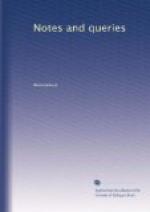W. Bell.
Damasked Linen.—I should feel obliged for any information on the earliest specimen of tablecloths being “damasked,” and the history of that manufacture. I have lately had shown me as “family curiosities” a beautiful “damask service” of Flemish or Dutch work. The centre contained a representation of St. George and the Dragon. The hero is attired in the costume of the latter part of the seventeenth century (?), with it cocked hat and plume, open sleeves and breeches, heavy shoes and spurs: with this motto in German characters over him,
[German: Ben Gott ist Rath und That,]
“With God is counsel and deed.”
At each corner of the cloth and napkins is a representation of a female figure kneeling on a rock, with clasped hands, with a lamb by her side (Query, St. Agnes?) On the border, at the top and bottom, St. George is figured in armour stabbing with a spear an alligator; and then with a sword, in the act of killing a bear.
On the side borders, he is receiving the attack of a lion on his arm, covered with a mantle; and then, with a raised sword, cutting at the proboscis of an elephant. I have seen, also, an older specimen, I think, of the same manufacture; the subject being the “Bear and Ragged Staff,” on alternate rows, with figures of trumpeters. I know not if this subject is of sufficient interest for your “Notes and Queries,” but I trust you will make what use of it you please.
R.G.P.M.
Flourish.—We are told that a writer flourished at such and such a time. Is any definite notion attached to this word? When it is said of a century there is no difficulty; it means that the writer was born and died in that century. But when we are told that a writer flourished about the year 1328 (such limitation of florescence is not uncommon), what is then meant? What are we to understand he did in or about 1328?
M.
Drax Abbey and Free School.—Can you, or any of your intelligent contributors, direct me where I can find any records of Drax Abbey, near Selby, Yorkshire, or of the Free School in Drax, endowed by Robert Reed, whom tradition states to heave been a foundling amongst the reeds on the banks of the Ouse, about half a mile distant. Such information will place me under great obligation.
T. Dyson.
Gainsboro.
Ancient Catalogue of Books.—A few days since I made the acquisition of a curious old catalogue {200} of books, interleaved, and containing about 200 pages, with the following title:
“Catalogus Variorum, in quavis Facultate et materia Librorum incompactum Officinae Joannis Maire, quorum Auctio publice habebitur in aedibus Joannis Maire, hora octava matutina et secunda postmeridiana ad diem ——, 1661. Lugduni Batavorum, ex Typographia Nicolai Herculis, 1661.”
On the back is the following notice to “buyers:”




